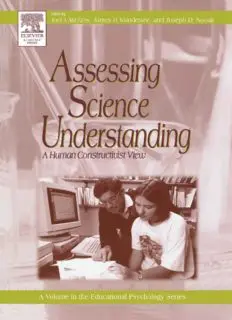
Assessing Science Understanding: A Human Constructivist View (Educational Psychology) (2004) PDF
Preview Assessing Science Understanding: A Human Constructivist View (Educational Psychology) (2004)
Assessing Science Understanding This is a volume in the Academic Press EDUCATIONAL PSYCHOLOGYS ERIES Critical comprehensive reviews of research knowledge, theories, principles, and practices Under the editorship of Gary D. Phye Assessin Science Understanding A Human Constructivist View EDITED BY Joel J, Mintzes Department of Biological Sciences University of North Carolina at Wilmington and Department of Math, Science, and Technical Education North Carolina State University James H, Wandersee Joseph D. Novak Graduate Studies in Curriculum Department of Education and Instruction Cornell University Louisiana State University Ithaca, New York Baton Rouge, Louisiana ELSEVIER Elsevier Academic Press 30 Corporate Drive, Suite 400, Burlington, MA 01803, USA 525 B Street, Suite 1900, San Diego, California 92101-4495, USA 84 Theobald's Road, London WC 1X 8RR, UK Cover photograph: Images © 1999 Photodisc, Inc. This book is printed on acid-free paper. Copyright © 2005, Elsevier Inc. All rights reserved. No part of this publication may be reproduced or transmitted in any form or by any means, electronic or mechanical, including photocopy, recording, or any information storage and retrieval system, without permission in writing from the publisher. Permissions may be sought directly from Elsevier's Science & Technology Rights Department in Oxford, UK: phone: (+44) 1865 843830, fax: (+44) 1865 853333, e-mail: [email protected]. You may also complete your request on-line via the Elsevier homepage (http://elsevier.com), by selecting "Customer Support" and then "Obtaining Permissions." Library of Congress Cataloging-in-Publication Data British Library Cataloguing in Publication Data A catalogue record for this book is available from the British Library ISBN: 0-12-088534-4 For all information on all Elsevier Academic Press publications visit our Web site at www.books.elsevier.com Printed in the United States of America 04 05 06 07 08 09 9 8 7 6 5 4 3 2 1 Deah, Binah, Vehascael On Knowledge, Understanding, and Wisdom Unless a man clearly understands and inwardly digests What he studies, let him read ever so much; he can Only be compared to a box well filled with books. Like that box, he carries books within him, and Like the box he is none the wiser for it. Talmudic Saying This Page Intentionally Left Blank Contents Contributors xvii Preface xJx 1. LEARNING, TEACHING, AND ASSESSMENT: A HUMAN CONSTRUCTIVIST PERSPECTIVE Joseph D. Novak, Joel J. Mintzes, and James H. Wandersee The Role of Assessment 1 The Learner 2 The Teacher 7 Knowledge and Knowledge Creation 8 The Social Milieu 11 A Foreword 13 References 13 2. ASSESSING SCIENCE UNDERSTANDING THROUGH CONCEPT MAPS Katherine M. Edmondson Concept Mapping to Portray Shared Meaning and Meaningful Learning 19 Concept Maps as Assessment Tools 22 Cases in Point: Assessing Shared Meaning in Specific Disciplines or Content Domains with a View to the Larger World 30 Summary and Conclusions 35 References 36 3. ASSESSING SCIENCE UNDERSTANDING: THE EPISTEMOLOGICAL VEE DIAGRAM Joel J. Mintzes and Joseph D. Novak Understanding Understanding 42 °° VII viii Contents Sharing Meanings (Intersubjectivity) 43 Resolving Inconsistencies (Coherence) 44 Seeking Simplicity (Parsimony) 46 Thinking Critically (Transparency) 47 Introducing Gowin's V Diagram 47 Focus Question 49 Objects and Events 50 Conceptual (Thinking) Side 50 Methodological (Doing) Side 52 V Diagrams in College Biology 54 Template and Rubric 54 Blaine 57 Melodie 57 Corrie 60 Comments and Reflections 60 V Diagrams in College Biology 60 Improvement of Laboratory Study Guides 62 V Diagrams in Junior High School 64 The Need for Greater Epistemological Understanding 66 References 68 4. "WHAT DO YOU MEAN BY THAT?": USING STRUCTURED INTERVIEWS TO ASSESS SCIENCE UNDERSTANDING Sherry A. Southerland, Mike U. Smith, and Catherine L. Cummins The Need for Qualitative Assessment Tools 72 What Is a Structured Interview? 73 Structured Interview Tasks 73 Interviews about Instances 74 Prediction Interviews 76 Sorting Interviews 79 Problem-Solving and Process Interviews 82 Conducting Structured Interviews 84 Practicalities of Preparation 84 Student Comfort 84 Timeframe 85 Prompts, Follow-Up Questions, and Interviewer Comments 85 Pilot Studies 87 Potential for Formal Evaluation 88 How to Make Sense of Interview Responses 89 Issues to Consider in the Use of Structured Interviews 90 Mode Validity 90 Content Specificity 91 Contents ix Using Structured Interviews to Inform Teaching 91 References 92 5. DIALOGUE AS DATA: ASSESSING STUDENTS' SCIENTIFIC REASONING WITH INTERACTIVE PROTOCOLS Kathleen Hogan and JoEllen Fisherkeller The Knowledge and Reasoning Connection 96 Broadening Conceptualizations of Scientific Reasoning 97 Using Verbal Interactions to Assess Scientific Reasoning 100 Steps for Assessing Reasoning Through Verbal Interactions in Classroom and Interview Contexts 102 Step 1: Determine a Purpose and Approach 102 Step 2: Establish and Communicate Standards for Reasoning 104 Step 3: Choose Interactive Settings for Assessment 106 Step 4: Choose Tasks for Eliciting and Assessing Reasoning 110 Step 5: Collect Data 113 Step 6: Analyze Data 115 Step 7: Give Feedback or Make Claims 122 Challenges, Caveats, and Conclusions 123 References 124 6. DESIGNING AN IMAGE~BASED BIOLOGY TEST James H. Wandersee What Can an Image-Based Test Reveal about Biology Learning? 131 What Are the Testing Implications of Paivio's Dual Coding Theory? 132 What Are Some Salient Principles of Visual Perception and Cognition? 133 How Can the Student's Attention be Focused on Selected Aspects of the Photographic Image? 135 When Should a Color Image Be Used Instead of a Monochrome Image? 135 What Is the Author's Model of Image-Based Biology Test-ltem Design? 136 What Are Some Examples of Model-Based Test Items? 138 How Can Image-Based Biology Test Results Be Analyzed and Interpreted? 138 References 142
